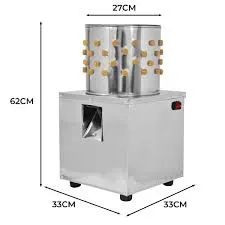Compact and Efficient Feed Processing Equipment for Small-Scale Farming Operations and Livestock Management
ágú . 11, 2024 04:34 Back to list
Compact and Efficient Feed Processing Equipment for Small-Scale Farming Operations and Livestock Management
The Role of Small Feed Processing Machines in Agriculture
In the ever-evolving landscape of modern agriculture, small feed processing machines have emerged as essential tools for farmers aiming to improve their livestock productivity and efficiency. These compact machines allow farmers to produce high-quality feed tailored to the specific nutritional needs of their animals. As the global demand for animal protein rises, the significance of these machines cannot be understated.
Understanding Small Feed Processing Machines
Small feed processing machines are designed to grind, mix, and pelletize various feed ingredients. These machines generally consist of a grinder or crusher, a mixer, and a pelletizing unit. They can handle diverse materials, including grains, legumes, and by-products from crop production, making them versatile for different agricultural settings.
One of the primary benefits of these machines is their ability to produce custom feed formulations. Farmers can select the ingredients based on the species of livestock, age, and health status, ensuring that animals receive balanced nutrition. This customization contributes to better feed conversion ratios, ultimately enhancing growth rates and overall productivity.
Benefits of Using Small Feed Processing Machines
1. Cost-Effectiveness Purchasing commercial feed can be expensive, especially for smallholder farmers. By utilizing small feed processing machines, farmers can make their own feed, significantly reducing expenses. They can buy raw materials in bulk, which are often cheaper than processed feeds.
2. Better Quality Control When farmers produce their own feed, they have complete control over the ingredients and their quality. This ensures that the feed is fresh and devoid of harmful additives, leading to healthier livestock.
small feed processing machine

3. Efficient Resource Utilization Small feed processing machines allow farmers to use local agricultural waste products, such as corn stalks, rice bran, and other by-products, to create nutritious feed. This not only reduces waste but also promotes sustainability within farming practices.
4. Enhanced Livestock Health Tailoring feed to the specific needs of animals can lead to better health outcomes. This means safer and healthier meat, milk, and eggs for consumers, while also supporting the immune system of the animals, reducing veterinary costs.
5. Adaptability and Scalability These machines are typically compact and user-friendly, making them suitable for small farms and cooperatives. As demand grows, farmers can scale up their feed production or diversify their offerings without significant investment.
Challenges and Considerations
While small feed processing machines offer numerous advantages, potential users should also be aware of challenges. Initial investment costs, although lower than large-scale operations, can still be significant. Additionally, knowledge of feed formulation is crucial; farmers must understand the nutritional needs of their livestock. Training and ongoing support can help mitigate these issues.
Moreover, regular maintenance is necessary to ensure the longevity and efficiency of these machines. Farmers should be prepared for periodic repairs or upgrades as their operations expand.
Conclusion
Small feed processing machines represent a valuable innovation in the agricultural sector. By enabling farmers to produce tailored, high-quality feed affordably, these machines support better livestock health, enhance food security, and promote sustainable farming practices. As global agricultural demands continue to increase, the adoption of small-scale feed processing technology will be instrumental in shaping the future of farming, offering an accessible means for farmers to thrive in a competitive industry. Through careful investment and training, small feed processing machines can transform the farming landscape, one bag of feed at a time.
-
High Performance Exhaust Fan – Efficient Ventilation Solutions for Home
NewsJun.10,2025
-
High-Quality Gestation Pen for Sows Durable Mobile Pig Pen & Simple Pig Pen Solutions
NewsJun.10,2025
-
High Quality Rabbit Cage Double Tier Designs & Welded Wire Mesh Supplier
NewsJun.10,2025
-
Floating Fish Feed Machine - High Efficiency Floating Fish Feed Extruder for Small Scale Production
NewsJun.10,2025
-
Premium Poultry Housing Solutions Mobile & Commercial Free Range Options
NewsJun.10,2025
-
Industrial FRP Fans Corrosion-Resistant Blades & Centrifugal Systems
NewsJun.09,2025






